Media relations is how you tell your story and get your message out through various media channels. Typically, this means hooking journalists, editors, and producers with a carefully crafted pitch to secure coverage. The ultimate goal of media relations, like any form of public relations, is to maximize positive coverage of you or your organization, giving you both visibility and a prominent voice in public discussions about your field or industry.
Find your key messages
Developing key messages is an important foundational step to successful media relations — and all creative communications. Key messages are essential for your organization: they underline what you believe in and what differentiates you.
In media relations, these are the core points you want the audience to remember — your key messages are what creates meaning for an audience, and, ideally, headline the conversations you want to be a part of. There are dozens of other organizations in your industry out there — what makes you unique? These messages act as a guide to help you cut through media noise.

Building a media relations plan
Once armed with your key messages, your next step is to build a media plan. This begins by identifying what your news is. Do you have a new product announcement? New research and insights? Do you want to set yourself up as a thought leader? Or maybe you just want to build awareness for your organization. This will help you understand your objectives and set success metrics to measure at the end of the campaign.
Next, you need to identify your audience — who is it you want to consume your message? From here, your media relations team will work with you to build a customized and highly targeted media list, identifying journalists and influencers who would be interested in what you have to say and who will get your message out in front of the right audience.
Once your media plan is firmly in place, your media relations team will craft pitches that tell your story through an engaging, newsworthy angle. These storylines will be interwoven with your key messages. Then the pitching begins — lots of emails, lots of phone time. And ultimately, some awesome coverage.

How to speak to media
Before media starts calling, it’s essential to identify your key spokespeople. For any story, your primary spokesperson should be someone who is comfortable speaking about and representing your brand. Often, this is a senior-level person in your organization who specializes in the subject area the interview is on. For instance, your CEO or CFO may tackle a business story, while your VP of product development would be a natural fit to discuss a new, exciting product launch.

This is where some media training may be essential. There is nothing natural or intuitive about doing a media interview. By being prepared, calm and confident, the interviewee can provide information that underlines your organization’s key messages, ensuring both parties walk away from the interaction having achieved their objectives.
Relationships are at the core of media relations
Like sea anemones and Nemo, media relations is a symbiotic relationship between journalism and public relations, both coming to the table with specific needs. One of the biggest benefits for journalists is quick, easy access to story ideas and expert sources. Journalists work on deadline, and establishing a relationship with credible industry leaders helps cut down on time needed to look for sources and dig for supporting information needed to substantiate their article.
Like sea anemones and Nemo, media relations is a symbiotic relationship between journalism and public relations
On the flip side, media relations allows individuals and organizations to reach a large audience for a fairly low cost. It’s important to remember that a media interview is always a give and take. No one likes the friend who only shows up when they want something. This might mean that not every interview results in coverage, but each interaction goes into establishing the interviewee as a helpful, friendly go-to source when relevant stories do arise.
That said, it is important to always keep your organization’s core messages and objectives in mind. The best interviews are conversations, and a seasoned spokesperson will look for opportunities to help direct the conversation to ensure it satisfies their needs as well as the needs of the journalist.
Monitoring and Reporting
Even once the story is out, the work is not done. Monitoring and reporting on coverage is an important post-campaign activity that helps you identify where you were successful and what could be improved upon. An essential part of every media relations effort is measuring specific success metrics like brand mention, target audience, and tier one publications. These will help you understand how successfully you were able to disseminate your message through your media efforts — essentially, to see how well your media plan worked.

Compiling dozens of news stories and summarizing insights in a meaningful way can be a cumbersome task. That’s why we built Stack, a media reporting tool which provides clients with meaningful insights and a flexible, engaging report experience. It helps our clients see the results of their efforts in real time, and makes it easier to identify key strengths and weaknesses for the next round of coverage.
We’ve got it covered
Great coverage doesn’t happen by accident. It takes time, planning and effort to hone your story and build your relationships. But few things can pay off like the right story at the right time.
Want to learn how we can help get the word out about your organization? Get in touch!